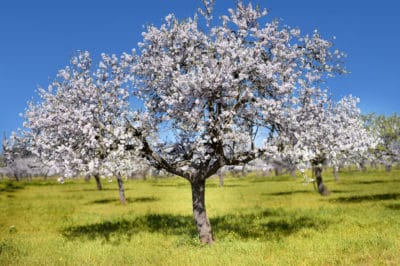The Right Climate
Almond trees need warm, dry summers and winter temperatures falling between 33° and 45°F (0.55° to 7.2°C) long enough to stimulate bud production. That means between 250 and 500 chilling hours per winter, depending on the cultivar.
USDA Plant Hardiness Zones
Almond treesgrowin USDA zones 5 through 10. California’s almonds – the most commercialized in the world – all grow in zones 9 and 10. They also do well in Texas, Arizona and central Florida.
The Right Site
Plant almonds in a shade-free location with rich, well-draining soil. Sandy loam amended before planting with an organic, high-nitrogen, high-phosphorous fertilizer is best. Allow 15 to 20 feet between trees.
Pollination
Only the ‘All-in-One’ almond cultivar self-pollinates. As a bonus, it cross-pollinates all other cultivars. Semi-dwarf ‘All-in One’ grows in USDA zones 7 through 9 and needs 500 chilling hours.
Cross-Pollination
All other almonds require cross-pollination, with bees and other insects carrying pollen between trees. If you aren’t growing ‘All-in-One,’ plant cultivars that cross-pollinate successfully.
Proper Planting
Plant your almonds in February, when temperatures are usually till cool enough to prevent blooming. To plant them:
- Water the trees thoroughly.
- Dig holes large enough to hold the root balls with the tap roots fully extended.
- Gently spread the roots to remove tangles
- Plant the trees as deep as they were in their pots.
- Replace the soil in each hole, tamping lightly as you go to eliminate air.
Watering
Water new plantings to saturate the soil and then weekly until new growth appears. With rainfall, they need 2 to 3 inches of weekly water (more during drought. Never let water pool around their trunks.
Spring and Summer Fertilizing
When their spring shoots are 4 to 6 inches long, sprinkle 1/2 cup of high-nitrogen fertilizer in a circle 18 inches from the base of each tree. Water it in and repeat twice during summer. Give each mature tree 30 pounds of well-aged manure every spring.
Winter Pruning and Pest Control
Prune dormant almonds in December or January. Remove damaged or crossed branches and suckers and thin their canopies to allow more sun. Remove weeds and debris that may harbor navel orange worms. To eliminate peach twig borers, scale insects and mites, start spraying with organic neem oil at the manufacturer’s recommended frequency.
